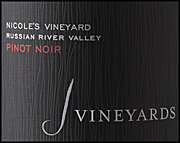
This year I have tried many Pinot Noirs. One consistent theme you will find is the best Pinots are not inexpensive. I am sure that fact does not surprise many Pinot lovers. However, there is a little good news from this list. At least the high prices of these recommendations are not as crazy as the best Burgundies or cult Cabernets that I recommend in the fall. Lovers of the Pinot Noir grape will have to spend between $30 and $70 to drink the best Pinots that I covered. But compare that to the top Cabs and it will seem inexpensive. For those looking for real bargains, I will also highlight some Pinots that are Very Good and cost less than $20. But none of these options crossed over into the 90 point range.

So let’s start with my favorite Pinot that scored Excellent and received 95 points. The 2008 Donum “West Slope” Pinot Noir from Carneros is fantastic! That is the good news. The bad news is that it costs $80 and only 170 cases were made, so finding a bottle will likely be a challenge. It was medium-bodied, very well-balanced, and smooth as silk. I loved its delicious mild red-raspberry flavors with notes of red currant with hints of red beet and cola. It finishes dry and its fine tannins fade away nicely. It was a great Pinot and one that is worth the search.

Our next Pinot is from J Vineyards. It was my favorite from their portfolio this year and perhaps since I have been covering their wines. The 2008 “Nicole’s Vineyard” Pinot Noir for $50 is Excellent. I scored it 94 points. There were also 720 cases made so it should be easier to find than the Donum. This offering is full-bodied, extremely smooth and elegant. It displays delicious mild black cherry flavors with hints of black-raspberry and just a kiss of licorice. I loved its very refined finish. It would be perfect with filet mignon.

The 2009 Siduri “Russian River Valley” Pinot Noir for $30 is the best deal amongst the highly rated Pinots. It scored 93 points and is even more plentiful with 1,350 cases made. It won our blind tasting of mid-tier priced Pinot Noirs. The panel described this Pinot as medium-bodied and lip smacking with very tasty black-raspberry flavors. They also detected hints of cherry, oak, pepper, and spice. They concluded that its well managed moderate tannins are food-friendly and would allow it to pair well with grilled salmon or roasted pheasant with sage. This next wine was my favorite from the 2009 vintage releases from Dutton Goldfield. Their 2009 “Devil’s Gulch Vineyard” Pinot Noir from the not-so-famous AVA of Marin County will make a lasting impression on you. I awarded this Pinot 93 points. It is balanced, savory, and fruit-forward. I really enjoyed its complex blend of very tasty black cherry and cola flavors with additional notes of black-raspberry, oak, and milk chocolate mixed in as well. It’s a very flavorful and special Pinot that would pair well with cherry amaretto chicken.

The next two 93-pointers come from Merry Edwards. You will find most of Merry’s Pinots in this report and consistently near the top of the list. The Coopersmith offering seems to consistently top my list of Merry’s wines each year and the 2008 is no exception. This Pinot costs $57 and is worth every penny. It opens with an attractive boysenberry bouquet with hints of musty oak and blueberry. I really liked its very tasty mild black-raspberry flavors with some gently integrated smoky oak. Its mild fine tannins make it food-friendly and a perfect companion for pork tenderloin. Merry’s other 93-pointer is the 2008 “Klopp Ranch” Pinot for $57. This offering is full-bodied, very well balanced and smooth. It displays delicious black currant flavors with notes of black-raspberry, black licorice, and a touch of oak towards the end. Its well managed tannins are pleasantly prolonged and make it a very good fit to pair with filet mignon.

The 92-pointers are all pretty pricey. But the first one I am going to cover is a steal for $38. The 2009 Benovia “Sonoma Coast” Pinot Noir is a very impressive offering. It opens with an attractive strawberry and black raspberry bouquet. On the palate, it is very well balanced and smooth. I really liked its very tasty black cherry flavors with notes of beautifully integrated oak and black-raspberry. Its fine tannins make this a rather elegant Pinot to consider for many meals and occasions. The next group of Pinots was my favorites from Oregon. We will start with the 2009 Elk Cove “Five Mountain” Pinot Noir for $48. It originates from the Willamette Valley. It is medium-bodied, smooth, and quite savory. Its flavor profile is a very tasty black-raspberry with hints of oak, black-cherry, and black pepper. It paired perfectly with my fresh sweet potato ravioli smothered in a brown butter sage sauce.

The next 3 Pinots are all 92-pointers from Cristom. They all cost $50 and come from Eola-Amity Hills in Oregon. We will start with the 2007 “Louise Vineyard” Pinot Noir. It was clearly one of the top Pinots that I have covered from the 2007 Oregon vintage. It was medium to full-bodied and smooth. I was impressed by its delicious black-raspberry flavors with notes of very pleasant and nicely integrated oak. This yummy Pinot would be a perfect match with a seasoned pork tenderloin. Next up is the 2008 “Eileen Vineyard” Pinot Noir. This Pinot is a little different in that it is medium-bodied, very well balanced, and a little more fruit-forward. Its flavor profile is a tasty mild black currant with hints of gentle black-raspberry, smoky oak and some minerals. Its very refined tannins allow it to finish smooth and leave an elegant impression. It would be good match for filet mignon. The final Cristom offering is the 2008 “Jessie Vineyard” Pinot Noir. It is medium-bodied, slightly acidic, and juicy. I really enjoyed its very tasty plum and mild black-raspberry flavors blended with a hint of blueberry and gentle oak. It would be very nice with a thick cut of prime rib. These three Cristoms are all quite different and really show what a difference terroir and vintage can make. The next 92-pointer is from J Vineyards. Their varietal program is taking off and you should definitely check out their Pinots and Chards. I would start with the sensuous 2008 “Barrel 16″ Pinot Noir for $50. There were only 300 cases made so I would start looking soon. This offering is rather refined and displays tasty and gentle black cherry flavors with a hint of black-raspberry. This Pinot is delicate, feminine, and elegant. You could easily drink a bottle with a companion and enjoy a memorable romantic evening.

Tom Eddy tells a great story about this vineyard. You should ask him next time you see him. Better than the story is the wine that is produced from this wonderful vineyard. The 2009 “Manchester Ridge Vineyard” Pinot Noir from Mendocino County is a fantastic Pinot. It opens with an attractive mild raspberry bouquet that leads to a very well balanced and elegant palate presence. Its flavor profile is a delicious gentle black cherry with a hint of black-raspberry and cola. This terrific Pinot Noir is very food-friendly and would be a perfect companion with grilled salmon.

Our final 92-pointer is from Alysian. Alysian is Gary Farrell’s new project. His 2008 “Rochioli Vineyard River Block” Pinot Noir for $65 is medium-bodied, well-balanced, juicy, and suave. It displays a blend of tasty mild red-raspberry and strawberry flavors with hints of cinnamon, plum and oak. Like the two above, it is refined and elegant. It would pair perfectly with Colorado rack of lamb.

At the 91-point level we have five Pinots to tell you about. The first two are bargains in terms of price to quality. We will start with the 2009 Paul Hobbs “CrossBarn” for $35. This Pinot is from the Sonoma Coast. It is full-bodied, balanced, and fruit-forward. It shows off its tasty red-raspberry jam flavors right away. It also has notes of black cherry and cranberry mixed in. It finishes with fine tannins are elegant and allow it to be very food-friendly. We would recommend good value Pinot with sliced pork tenderloin with a wild mushroom risotto. Our next deal is from Merry Edwards. Her 2008 “Sonoma Coast” Pinot Noir for $36 is a lot of wine for the money. The other good news is she made 4,450 cases of it, so you should be able to find it. It is medium-bodied and savory with tasty oak infused tart black plum flavors with notes of chocolate and black cherry mixed in. Our panel suggested pairing this gem with a veal chop.

Our next Pinot comes from the Willamette Valley in Oregon. The 2009 Elk Cove “Mount Richmon” Pinot Noir is a perfect match for grilled salmon. It is elegant in style, medium-bodied, and shows mild fruit forward flavors. I really enjoyed is very tasty mild red currant flavors with notes of black-raspberry and a hint of oak. This Pinot finishes gently because of its fine tannins. Enjoy it with the salmon. It costs $48 per bottle.

The next 91-pointPinot is my second favorite Pinot offering from Dutton Goldfield. Their 2009 “McDougall Vineyard” Pinot Noir from the Sonoma Coast opens with fragrant black currant bouquet with notes of black-raspberry and beets. Yes, beets. It is slightly acidic, rather juicy and fruit forward. It displays tasty mild raspberry flavors with hints of oak and strawberry. It would go well with veal scallopini.





















